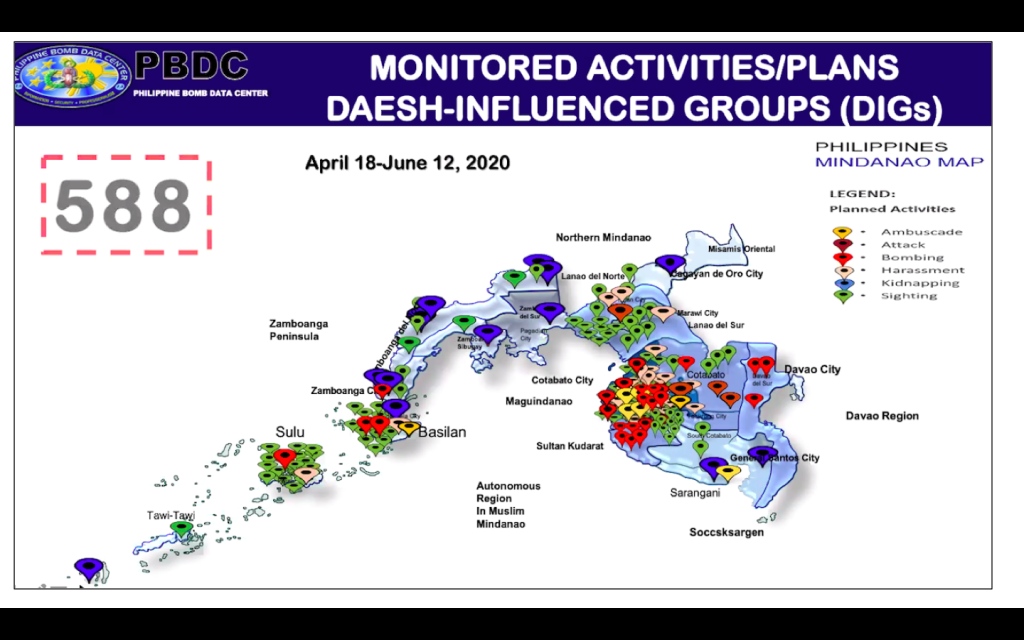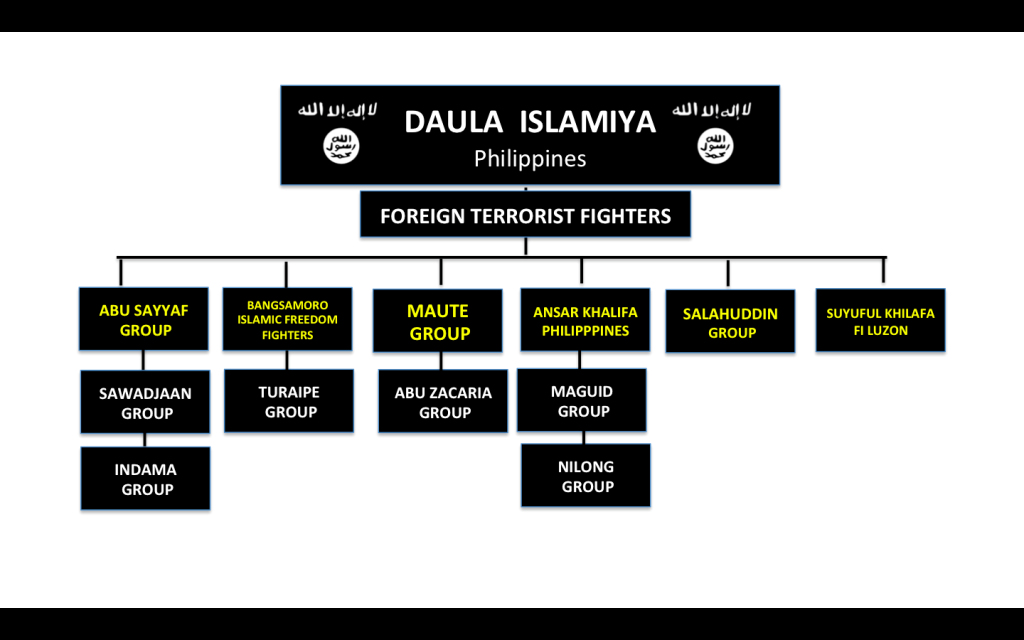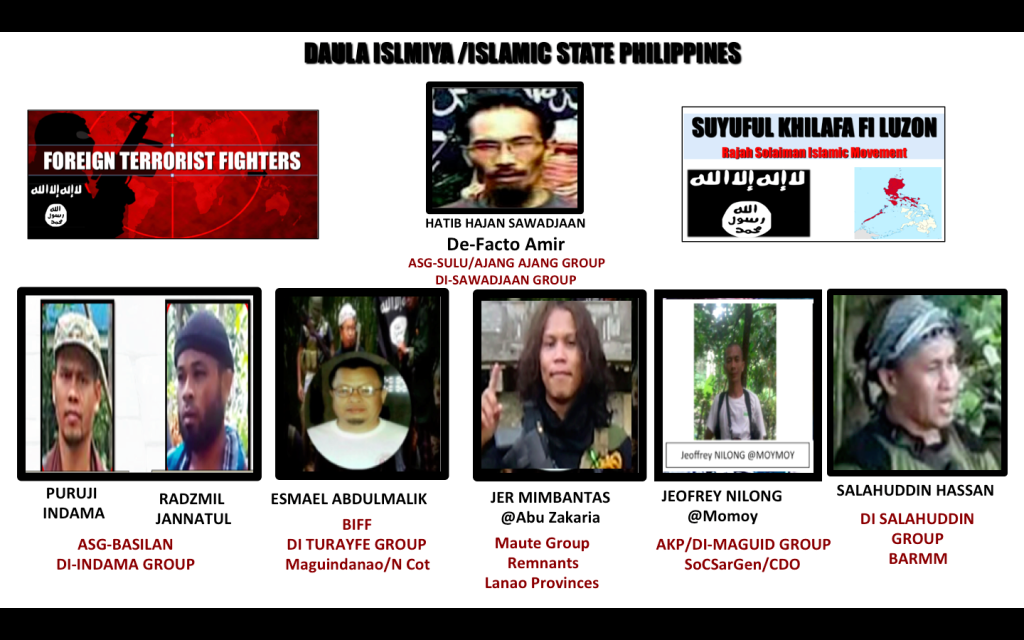Philippines: Threats Of Violent Extremism And Terrorism Amidst COVID-19 Pandemic – Analysis
By PIPVTR
The world at present faces two deadly pandemics: COVID-19 pandemics and the pandemics of terrorism. Both carry noxious viruses that are contagious, lethal, and virulent.
By Rommel C. Banlaoi*
Amidst the COVID-19 pandemic, terrorist threats worldwide continue unabated. In fact, international terrorist groups are taking advantage of the pandemic to propagandize, recruit and mount violent attacks. The Islamic State of Iraq and Syria (ISIS), for example, is currently experiencing a rapid resuscitation as the pandemic is providing the group the needed oxygen to recover. The Philippines is one of the countries most affected by the twin threats of terrorism and COVID-19 pandemic.
Terror Threats Persist Worldwide During the Pandemic
According to the Country Reports on Terrorism published by the Bureau of Counterterrorism of the US State Department in June 2020, dangerous terrorist threats persisted around the world.[1] Though ISIS already lost some of its key leaders and major territories as a result of the US-led Global Coalition to Defeat ISIS, the group has effectively adapted “to continue the fight from its affiliates around the globe and by inspiring followers to commit attacks”.[2]
While the whole world is preoccupied overcoming the terrifying onslaught of COVID-19, ISIS is mounting a global resurgence.[3] ISIS is exploiting the pandemic to ramp up attacks in areas where they still maintain significant followers beyond Iraq and Syria. ISIS even regards the coronavirus as the “soldier of Allah” that is part of the global jihad against the infidels.
Thus, the world at present faces two deadly pandemics: COVID-19 pandemics and the pandemics of terrorism. Both carry noxious viruses that are contagious, lethal, and virulent. Until now, we are still in search of an effective vaccine to halt these viruses from spreading fear and wreaking havoc to the whole of humanity.
The Philippines: COVID-19 Hotspot and Epicenter of Terror Threats in Southeast Asia
The Philippines is not spared from the threats of these twin pandemics. The Philippines has become the COVID-19 hotspot in Southeast Asia with close to 130,000 confirmed cases to date. The Philippines has almost doubled the infection rate in China, the ground zero of infections. The COVID-19 pandemic is providing ISIS followers in the Philippines the conducive environment to spread violent extremism and to sow terror while taking advantage of law enforcement authorities preoccupied in implementing quarantine measures to contain the spread of the disease.
Since March 2020, ISIS followers in the Philippines have conducted around 700 violent attacks amidst the pandemic based on military intelligence reports. From 18 April to 12 June 2020 alone, at the height of the first wave of the pandemic, the Philippine National Police (PNP) recorded 588 violent activities of ISIS followers in the country.

The most devastating attack, so far, was on 17 April 2020 when the ASG killed eleven and wounded 14 soldiers of the Philippine Army in a firefight in Patikul, Sulu.[4] The ASG ambushed the Philippine soldiers while they were conducting their hot pursuit operations against followers of Radullan Sahiron and Hatib Sawadjaan, two top ASG leaders in Sulu.[5]
The Philippines has, therefore, become the epicenter of ISIS terror threat in Southeast Asia. The Global Terrorism Index listed the Philippines as the only country in Southeast Asia belonging to the top-10 countries in the world most impacted by terrorism in its report in 2019.[6] It is very likely for the Philippines to be listed again as one of the countries most impacted by terrorism in 2020 with the persistence of terrorist activities in the Philippines during the COVID-19 pandemic.[7]
Rise of Suicide Terrorism in the Philippines
The face of terrorism in the Philippines has become more perilous with the rise of suicide terrorism. Three years after the Marawi siege, the Philippines suffered the following suicide terrorist attacks, so far:
- Lamitan City suicide bombing involving a German national with a Moroccan descent (31 July 2018)
- Jolo Cathedral suicide bombing involving Indonesian couple (27 January 2019)
- Indanan, Sulu suicide bombing involving a Filipino (28 June 2019)
- Indanan, Sulu female suicide bombing involving an Egyptian national (8 September 2019)
On 5 November 2019, the Philippine military foiled an attempted suicide bombing in Sulu when troops killed in action two Egyptian nationals in Jolo. The Philippine police, on the other hand, foiled another planned suicide terrorist attack in Metro Manila when agents killed four operatives of the Abu Sayyaf Group in their safe house in Parañaque City on 26 June 2020. The shooting incident involving military and police operatives in Jolo on 29 June 2020 was related to a military mission to run after female suicide bombers.
The rise of suicide terrorism in the Philippines arises from the contagious effect of the ideology of violent extremism propagated by ISIS foreign terrorist fighters in the country. ISIS foreign terrorist fighters capitalize on local grievances, historical animosities, and feeling of injustices to propagate violent extremism in the Philippines, particularly in conflict-affected areas of Mindanao. Violent extremism is the ideology that justifies acts of terrorism in the Philippines.
Where are the Threats of Violent Extremism andTerrorism in the Philippines Coming From?
During the pandemic, there are at least six active pro-ISIS terrorist groups operating in the Philippines:[8] the Abu Sayyaf Group (ASG), the Turaipe Group of the Bangsamoro Islamic Freedom Fighters (BIFF), the Abu Zacaria Group (AZG), the Nilong Group, the Salahuddin Group, and Suyuful Khilafa Fi-Luzon. All these groups belong to an umbrella organization described by the Philippine military as Daula Islamiya Philippines (DI-P) or Islamic State Philippines (ISP), which is the main base of the ISIS East Asia Wilaya or the Islamic State East Asia (ISEA) more known by followers as Wilayah Sharq Asia. Supporting these groups are foreign terrorist fighters coming largely from Indonesia and Malaysia but with significant personalities coming also from the Arab world, North Africa and Europe.

Abu Sayyaf Group
There are three known major factions of the ASG. Two of these factions are in Sulu. One is headed by Hatib Sawadjaan while the other one is headed by Radullan Sahiron.
Sawadjaan is a pro-ISIS leader known to be the de-facto Amir of DI-P or Daula Islamiya Alfalabin.[9] He pledged allegiance to ISIS in 2014. The Philippine military calls his group as Daula Islamiya Sawadjaan Group (DI-WG) with around 300 regular armed followers operating in Sulu, Tawi-Tawi and even Sabah. DI-SG is responsible for a series of suicide bombings in Sulu and kidnapping activities in Sabah.
Sahiron is not a pro-ISIS leader. He used to be affiliated with Al-Qaeda being one of the original founders of the ASG then under the leadership of Abdurajak Janjalani. Sahiron continues to be in the list of most wanted terrorists by the US State Department. But Sahiron slows down his violent activities during the rise of ISIS having been overshadowed by his erstwhile lieutenant, the late Isnilon Hapilon who became the leader of Daula Islamiya Wilayatul Mashriq (Islamic State Province in East Asia) responsible for the 2017 Marawi Siege. Sahiron continues to have around 50 armed followers operating mainly in his little kingdom in Patikul, Sulu.
Sahiron developed an adversarial attitude towards ISIS having suffered near-death experiences with Al-Qaeda operatives in Mindanao. Thus, he refused to pledge allegiance to ISIS.[10]
Another faction of the ASG is based in Basilan now headed by Furuji Indama who pledged allegiance to ISIS in 2014. He is a pro-ISIS leader who used to be the number two man of Hapilon who pledged allegiance to ISIS twice: in 2014 and 2016.
Indama has around 20 regular armed followers in Basilan with support network operating in Zamboanga City and Zamboanga Peninsula, particularly in Zamboanga Sibugay. Being a pro-ISIS leader, Indama also provides tactical support to the activities of Sawadjaan.
Turaipe Group
The Turaipe Group refers to the faction of the BIFF headed by by Esmael Abdulmalik (Alias Commander Turaipe/Turaifie). He pledged allegiance to IS in April 2017 just a month before the Marawi Siege. Commander Turaipe formed his own pro-IS group called Jama’ahtul Mujahirin Wal Ansar (JMWA) based largely in Datu Salibo town of Maguindanao.[11]
After the Marawi Siege, Commander Turaipe continued his armed activities in the provinces of Maguindanao and North Cotabato through ambuscades, roadside bombings, liquidations, and harassments on behalf of ISIS. Commander Turaipe even renamed his group as Daulah Islamiya Maguindanaw (DIM) or the Islamic State of Maguindanao, a pro-ISIS group responsible for most of the violent attacks in Maguindanao three years after the Marawi siege. The military calls his group as DI-Turaipe Group with more than 80 armed followers.
Zacaria Group
The Zacaria Group refers to remnants of the Maute Group. It is presently led by Commander Ker Mimbantas who is also known as Commander Zacaria or Commander Omar. He was one of the officers of the Maute Group, also known as the Daula Islamiya Ranao or the Islamic State of Lanao.
Commander Zacaria has around 40 armed followers operating mostly in Lanao del Sur and Marawi City. He used to work with the Maute brothers (Abdullah and Omarkayam) and Abu Dar. When these leaders died, he rose to prominence being the nephew of the late Alim Abdul Azis Mimbantas, the former Vice Chairman for Military Affairs of the Moro Islamic Liberation Front (MILF). The military calls the Zacaria Group as the Daula Islamiya Zacaria Group (DI-ZG).
Nilong Group
The Nilong Group represents the remnants of the Ansar Khilafa Philippines (AKP) then led by Mohammad Jaafar Maguid more known as Commander Tokboy. The group is being led by a certain Jeoffrey Nilong, alias Commander Momoy believed to be holding his makeshift camp in Polomolok, South Cotabato. The military calls this shadowy group as Daula Islamiya Nilong Group (DI-NG) with only around 10 followers operating mainly in the provinces of South Cotabato, Sarangani and General Santos of the Southern Philippines. The group was responsible for the bombing in General Santos in September 2018.[12]
Salahuddin Group
The Salahuddin Group is being led by Hassan Salahuddin, the first leader who pledged allegiance to the new ISIS Caliph, Al-Qurashi, on 11 November 2019. Salahuddin used to be a member of the Al Khobar Group (AKG), the Special Operation Group (SOG) of the MILF in the 1990s. The AKG was responsible for a series of extortion activities in Mindanao cities of Tacurong, Kidapawan, Koronadal and General Santos using skills in bomb making.
Salahuddin developed his skills in bomb making through his mentors, Basit Usman and Marwan (Zulkipli bin Hir) who were targets of Mamasapano clash on 25 January 2015. When Basit Usman organized the Al Khilafa Sarangani in 2012, Salahuddin joined him to conduct training on bomb making with pro-ISIS followers in Central Mindanao. When Basit Usman died on 3 May 2015 in a military encounter, Salahuddin joined the BIFF-Turaipe Group in order to establish the Daula Islamiya Maguindanao.
With the support of BIFF-Turaipe Group, Salahuddin masterminded the Isulan, Sultan Kudarat bombings on 28 August 2018 and 2 September 2018. DI-SG also coddles foreign terrorist fighters through the assistance of a long-time friend, Mauwiya, a Singaporean follower of Jemaah Islamiya. Mauwiya has been operating in Central Mindanao since the 1990s.
The military calls the Salahuddin Group as Daula Islamiya Salahuddin Group (DI-SG) with around 10 followers trained in bomb making. The group is operating mainly in Maguindanao and Sultan Kudarat provinces.
Suyuful Khilafa Fi Luzon
The Suyuful Khilafa Fi Luzon (SKFL) or the Soldiers of the Caliphate in Luzon operates mainly in Luzon, particularly in the National Capital Region (NCR), Ilocos Region and Bicol Region. Composed mostly of Muslim converts, the SKFL evolved from Jamal Al Tawhid Wal Jihad (JTJ) Philippines whose members pledged allegiance to ISIS in 2014. Members of JTJ Philippines were followers of Abu Musab Al Zarqawi who founded the JTJ in Iraq that became known as the Al-Qaeda in Iraq. After the death of Osama bin Laden, Al Zargawi reorganized the JTJ as the Islamic State in Iraq, the forerunner of the present day ISIS.
The SKFL cooperates with pro-ISIS groups operating in the NCR. The SKFL was responsible for several bomb threats and foiled bombing activities in Metro Manila during the Summit of the Association of Southeast Asian Nations (ASEAN) in November 2017 and the Summit of the Asia Pacific Economic Cooperation (APEC) in November 2016 as well as the visit to Manila of Pope Francis in January 2015. The SKFL was also responsible for several bomb threats in Northern Luzon in November 2019 threatening to attack Catholic churches.[13]
Though based in Luzon, the SKFL also operates in Southern Visayas and Northern Mindanao by penetrating Muslim converts or Balik Islam communities in these areas. However, the military only identifies more than ten active operatives of the SKFL pursuing violent activities.
Foreign Terrorist Fighters
Foreign terrorist fighters (FTFs) operating in the Philippines are foreign operatives of ISIS planning and conducting violent activities in the country, particularly in Mindanao. Intelligence estimates in 2018 indicated close to 100 pro-IS FTFs in the Philippines.[14] But intelligence estimates at the end of 2019 downgraded the figure to 59 “watch-listed” and 7 under hot-pursuit FTFs.[15] During the Marawi liberation; the AFP identified 32 dead bodies of FTFs from the ground zero.[16]
Most FTFs coming to the Philippines were from Indonesia and Malaysia while others came from the Arab World, particularly from Egypt and Saudi Arabia. From the 59 “watch-listed” FTFs, some are suspected to be coming from Europe, North Africa, and even from Xinjiang Province of China.
FTFs come to the Philippines to facilitate transfer of funds and weapons to local supporters, to conduct violent extremist propaganda activities, and to transfer skills in religious jihad.[17] FTFs also regard the Philippines as an alternative home base, a new land of jihad, and a very excellent sanctuary or safe haven because of domestic Muslim resistance, weak law enforcement, and very porous borders. More importantly, their local counterparts welcome the entry of FTFs despite their recent setbacks in Iraq and Syria.
FTFs can enter the Philippines through several backdoors from Sabah covering the maritime borders of the Philippines and Malaysia and from Manado covering the maritime borders of the Philippines and Indonesia.[18] But most of the FTFs have entered the Philippines through normal immigration process at the Philippine airports using budget airlines.

Conclusion
During the COVID-19 pandemic, threats of violent extremism and terrorism in the Philippines persist through the continuing activities of ISIS followers operating in the country. Though the COVID-19 pandemic has slowed the entry of FTFs to the Philippines, those who are already in the country continue to spread the ideology of violent extremism that encourages ISIS followers to commit various acts of terrorism, especially suicide terrorism.
Suicide terrorism is the current face of terror in the Philippines. ISIS is taking advantage of the pandemic to propagate the ideology of violent extremism and to support acts of terrorism in the Philippines by funding, training, and mobilizing pro-ISIS groups in the country.
In short, the Philippines is confronting the challenges of the twin pandemics from COVID-19 and ISIS. Overcoming these challenges needs an innovative countermeasure that is dynamic, comprehensive, holistic, inclusive and lawful.
*This paper was originally prepared for presentation at the Online Seminar Workshop on Conflict Monitoring and Research Methodologies for Population-Based Studies About Conflict, Terrorism and Peace and Development Initiatives organized by the Western Mindanao State University, Zamboanga City on 10 August 2020.
*About the author: Dr. Rommel C. Banlaoi is the Chairman of the Philippine Institute for Peace, Violence and Terrorism Research (www.pipvtr.org) and a Professorial Lecturer at the Department of International Studies, Miriam College, the Philippines. He is also the President of the Philippine Society for Intelligence and Security Studies
Source: This article was published by PIVTR
END NOTES
1. Bureau of Counterterrorism, Country Reports on Terrorism (Washington DC: US State Department, June 2020), p. 2.
2. Ibid.
3. Joseph Hincks, “With the World Busy Fighting COVID-19, Could ISIS Mount A Resurgence?”, Time, 29 April 2020.
4. Rommel C. Banlaoi, “Tackling the ASG: Need to Rethink Strategies,” RSIS Commentaries (Singapore: S. Rajaratnam School of International Studies, 8 May 2020). https://www.rsis.edu.sg/rsis-publication/rsis/tackling-abu-sayyaf-need-to-rethink-strategies/
5. Ibid.
6. Global Terrorism Index 2019: Measuring the Impact of Terrorism (Sydney: Institute for Economics and Peace, November 2019).
7. Rommel C. Banlaoi, “Terrorism In The Philippines During The Pandemic: Persistent Threats Three Years After Marawi Siege,” Eurasia Review, 15 May 2020. https://www.eurasiareview.com/15052020-terrorism-in-the-philippines-during-the-pandemic-persistent-threats-three-years-after-marawi-siege-analysis/
8. This section is an updated version of Rommel C. Banlaoi, “Three Years After Marawi Siege: Terrorism in the Philippines Persist Amidst COVID-19 Pandemic”, Think Pieces (Cotabato City: Institute for Autonomy and Governance, 22 May 2020) at http://iag.org.ph/think/1888-three-years-after-marawi-siege-terrorism-in-the-philippines-persists-amidst-covid-19-pandemic.
9. Peter Chalk, “The Islamic State in the Philippines: A Looming Shadow in Southeast Asia?”, CTC Sentinel, Vol. 8, Issue No. 2, March 2016.
10. Rommel C. Banlaoi, Al-Harakatul Al=Islamiyyah: Essays on the Abu Sayyaf Group, Terrorism in the Philippines from Al-Qaeda to ISIS, 4th Edition (Quezon City: Philippine Institute for Peace, Violence and Terrorism Research, 2019).
11. Terrorism Research and Analysis Consortium (TRAC), “BIFF/ISEA Unit Jamaah Mohajirin Wal Ansar”, 16 September 2018.
12. “Nilong Group Tagged behind GenSan Blast,” Mindanews, 19 September 2018.
13. “Philippines: Islamic State-Linked Terrorist Group Reportedly Plotting Attacks Against Northern Targets”, Stratfor Situation Report, 7 August 2019 at https://worldview.stratfor.com/situation-report/philippines-islamic-state-linked-terrorist-group-reportedly-plotting-attacks
14. Zam Yusa, “Philippines: 100 foreign fighters joined ISIS in Mindanao since the Marawi battle,” The Defense Post, 5 November 2018.
15. Raul Dancel, “Foreign terrorists in Mindanao training suicide bombers: Philippine security officials,” The Strait Times, 23 July 2019.
16 Zam Yusa, “Philippines military photos show children among ISIS foreign fighters killed in Marawi,” The Defense Post, 25 October 2018.
17. National Intelligence Coordinating Agency, “Terrorism Situation in Relation to the Threats of Foreign Terrorist Fighters,” 2 March 2020.
18. Zam Yusa, “Malaysia and Indonesia foreign fighter transit routes to Philippines identified,” The Defense Post, 20 November 2018.

